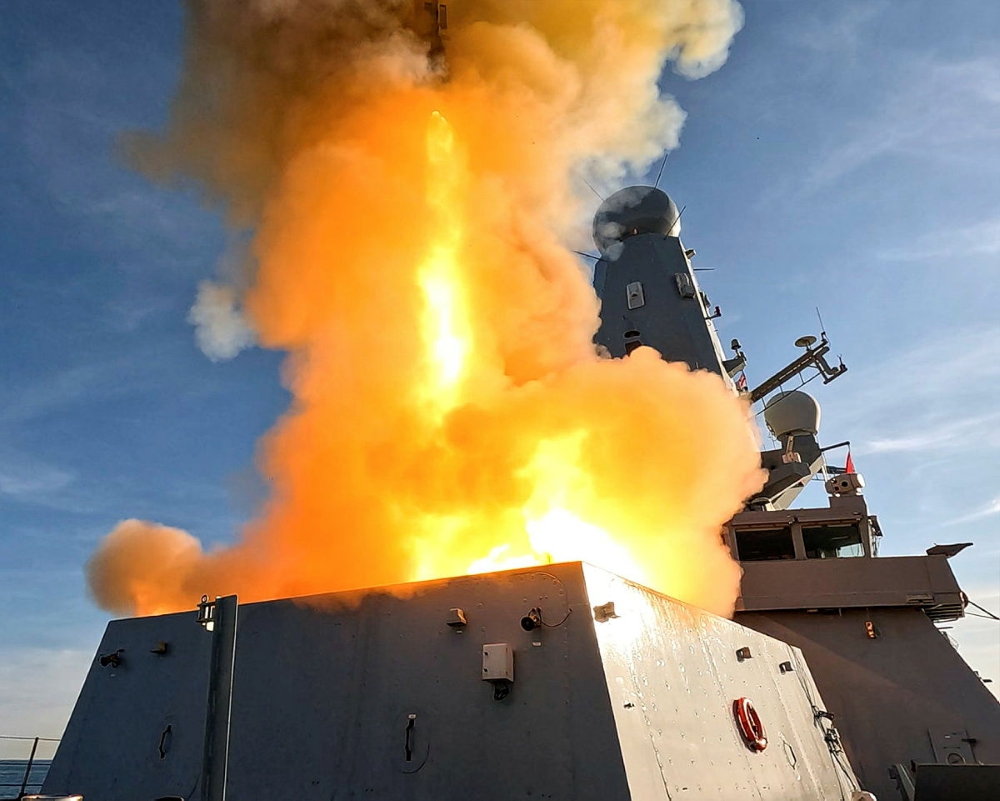
The periodic exercises of the FORMIDABLE SHIELD format are the most complex live firing events in Europe and represent the ultimate test for all navies involved. The exercise spans much of the North Atlantic, with a phase held off northern Norway and then a concluding event at the Hebrides, exploiting the facilities of the UK MOD, Qinetiq-operated, range there.
This year the first phase of the exercise lasted from May 5 to May 10th off Andøya in Northern Norway. A notable first in Norway was the involvement of the SGT STOUT Manoeuvre-SHORAD vehicles of the US Army, which fired for the first time ever in the context of a NATO exercise. The vehicles fired STINGER missiles on May 8 and were from the 5th Battalion, 4th Air Defense Regiment (5-4 ADAR).
At the Hebrides, the exercise saw NATO warships defending against subsonic and supersonic targets, short and medium range ballistic threats, surface suicide boat threats and drone swarming.
Qinetiq’s Combined Aerial Target Service (CATS), which operates under UK MOD contract to provide targets and simulated threats in the exercises, sent into action a small swarm of 4 QinetiQ BANSHEE WHIRLWIND Remote Piloted Aircraft Systems in close formation for the first time. They also provided other subsonic target drones and smaller, sUAS type threats for both warships and land forces to train against. Qinetiq also sent into action HAMMERHEAD surface uncrewed vehicle targets in integrated threat scenarios.
Another first was the involvement in the exercise of US Army elements which fired for the first time at the Hebrides since the 1960s. AVENGER vehicles and STINGER teams of the 1st Battalion, 57th Air Defense Regiment participated alongside elements from 30 Battery, 16 Royal Artillery Regiment. 16 RA is equipped with SKY SABRE (CAMM) missiles but it is not clear if they carried out live firings.
At sea, an important first was logged by the Royal Navy as TYPE 45 destroyer HMS DRAGON downed, for the first time, a supersonic sea skimming, highly manoeuvrable target, using a telemetric MBDA ASTER 30 missile.
The target was a Northrop Grumman GQM-163A COYOTE: 2 of these advanced targets were fired this year, with the other being shot down, again in sea skimming profile, by the French FS NORMANDIE, one of 2 modified AQUITAINE-class ships (FREMM) completed as FREDA (from “défense aérienne”). The modified AML 4K3 twin-arm launcher used to fire COYOTE targets was first installed at the Hebrides in 2021.
Other ships which live-fired include the Italian PPA Full GIOVANNI DELLE BANDE NERE which fired a telemetric ASTER 15. The Belgian frigate BNS LOUISE-MARIE fired both SEA SPARROW surface to air and HARPOON anti-ship missiles, while the Spanish ESPS CRISTOBAL COLON and the Canadian HMCS MONTREAL fired ESSMs.
The US Navy participated with the USS THOMAS HUDNER (DDG 116) and USS BULKELEY (DDG 84) which downed ballistic targets. DDG-116 was allocated a new Integrated Air and Missile Defense Target (IAMD-T), a recently developed medium-range ballistic missile threat designed to test the SM-2 and SM-6 in complex intercepts, including of hypersonic vehicles. IAMD-T first debuted operationally at PACIFIC DRAGON 2024 in the summer of last year and this launch at the Hebrides was a first. THOMAS HUDNER took down the threat with an SM-6. USS BULKELEY used a SM-3 missile to take out a more well known Aegis Readiness Assessment Vehicles (ARAV) Type B target (also known as T4B), a type of target that has been fired at the Hebrides for several years now. A couple of dedicated small hangars and launch pads at the Hebrides have been used to launch various ballistic targets for multiple years now.
Air Force elements were also involved, but fewer details have been revealed: the Royal Air Force posted photos of 2 TYPHOON fighters from 41 Squadron (the Operational Evaluation Unit for the type), one single-seater and a 2-seater. The single seater in the photos is clean of weapons and might have carried out live firings before being photographed (in flight, during air refuelling). The 2-seater is visibly fitted with 2 captive ASRAAM missiles with inert motor but live seeker head.
According to a DE&S press release, the Defence Munitions team coordinated the logistics movements of “over 3,000kg of munitions ranging from small arms to complex weapons”, with some of the weaponry involved taken to the Outer Hebrides by RAF A-400M.
Follow us on Telegram, Facebook and X.








.png)
